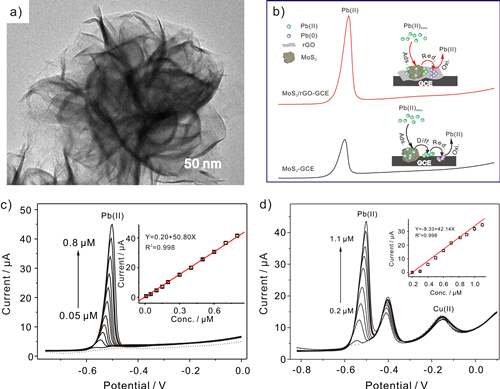Chinese researchers with Institute of Intelligent Machines, Hefei Institutes of Physical Science realized highly selective and sensitive detection of Pb(II) that is very hard to accurately sense for the mutual interference among the different heavy metal ions.
The team made flower-like MoS2/rGO composite with ultra-thin nanosheets to overcome problems in the detection and managed to achieve high performance selective and sensitive sensing of Pb(II).
Actually, electrochemical analytical tools have been widely used to detect Pb(II), and through which achievements have been made. However, the mutual interference among the different heavy metal ions is serious due to the intermetallic compounds formed among them and the competition for the active sites at the modified electrode surface.
Therefore, it is still a challenge, we have to face, to accurately detect real water samples contaminated by Pb(II) with interference by coexisting heavy metal ions.
In the recent study, the team found that MoS2/rGO nanocomposite presented highest adsorption capacity for Pb(II), which enabled its modified electrode to realize the selective and sensitive detection of Pb(II).
To further test, they performed their method in real water environment. According to the test in wastewater collected from sewage disposal plant in the local community, the team obtained the good test result that was in accordance with it in the lab.
Moreover, the team also took a closer look at the interference among the coexisting ions and they uncovered difference in the ability of MoS2/rGO nanocomposite to absorb different ions.
This work was supported by the postdoctoral innovation talents supporting project (BX20180311), the national natural science foundation of China (21735005), the technology major project of Anhui Province (17030801033), and the natural science foundation of Anhui Province (1708085MB36), the postdoctoral researcher funding project of Anhui Province (2018B244).
Link to the paper: Sensitive and anti-interference stripping voltammetry analysis of Pb(II) in water using flower-like MoS2/rGO composite with ultra-thin nanosheets

Figure 1. Morphologic structure and electrochemical detection studies. a) TEM image of the MoS2/rGO nanocomposite. b) The detection strategy of Pb(II). c) SWASV signal of the MoS2/rGO modified glassy carbon electrode (MoS2/rGO-GCE) toward Pb(II). d) SWASV signal of the MoS2/rGO-GCE toward Pb(II) in the presence of 0.5 μM Cu(II). (Imaged by YANG Meng)
Contact:
ZHOU Shu
Hefei Institutes of Physical Science (http://english.hf.cas.cn/)
Email: zhous@hfcas.ac.cn
 Tel: +86-551-65591206
Tel: +86-551-65591206
 Fax: +86-551-65591270
Fax: +86-551-65591270
 Emai: zhous@hfcas.ac.cn
Emai: zhous@hfcas.ac.cn
 350 Shushanhu Road
350 Shushanhu Road